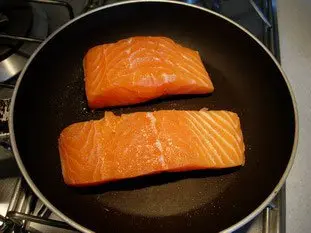This site uses only a few technical cookies necessary for its operation. By continuing to browse, you accept their use.
To find out more...
To find out more...
The skin side of the fish first?

When it comes to cooking fresh fish, if it's filleted with its skin on and you're planning to pan-fry it in a little olive oil, for example, you might ask yourself the following question: Which side, skin or flesh, should come into contact with the pan first?
26 K 4.4/5 (19 reviews)
Keywords for this post:FishCookingSkinFleshTipLast modified on: February 13th 2021
The skin side of the fish first?
You will probably read here or there that it is always the skin side first, we always grill longer on that side, and first, because we often want to get a nice crispness, when the skin is eaten, for whiting or sea bass for example.
This is often true, and for thick filleted fish, salmon for example, it allows to remove it quite easily once its side is cooked.
But for some thin fish, it is not always interesting: the skin stretches brutally in contact with the pan, and deforms the fillet into a bow.
This is very pronounced for red mullet, for example. It doesn't change the taste of the fish, but it makes it look a little less appetizing.
But if you start with the flesh side, the skin will not reach the desired crispness, or else with the risk that the fish is a bit overcooked.
You will notice at this point that even if the skin is still tense, the flesh, just seized, is much better, and your fillet does not deform, or less.
If necessary (fillet a little thick) finish with a third, short turn, on the flesh side, to finish browning well.
Another possible solution is to scarify the skin side over a few millimetres deep with a small, very sharp knife to prevent it from shrinking.
To sum up: For fine fish fillets whose skin is to be eaten, first cook the flesh side for 30 seconds, then cook the skin side normally.

This is often true, and for thick filleted fish, salmon for example, it allows to remove it quite easily once its side is cooked.

But for some thin fish, it is not always interesting: the skin stretches brutally in contact with the pan, and deforms the fillet into a bow.
This is very pronounced for red mullet, for example. It doesn't change the taste of the fish, but it makes it look a little less appetizing.
But if you start with the flesh side, the skin will not reach the desired crispness, or else with the risk that the fish is a bit overcooked.
What to do?
Try to proceed in 2 times at least: Frying pan quite hot, put your fillet on the flesh side first, let cook 30 seconds, just to seize, turn over (skin side down this time), and cook the necessary time.You will notice at this point that even if the skin is still tense, the flesh, just seized, is much better, and your fillet does not deform, or less.

If necessary (fillet a little thick) finish with a third, short turn, on the flesh side, to finish browning well.
Another possible solution is to scarify the skin side over a few millimetres deep with a small, very sharp knife to prevent it from shrinking.
To sum up: For fine fish fillets whose skin is to be eaten, first cook the flesh side for 30 seconds, then cook the skin side normally.
Lasts posts
Butter vs. grease
We often read in a recipe where a pastry is put into a mould that, just before pouring, the mould should be buttered or greased. But what's the difference between these 2 terms?December 1st 20257035
Getting out of the fridge early
Very often when you're cooking, you need to take food or preparations out of the fridge, to use them in the recipe in progress. There's nothing tricky about this: you just take them out of the fridge and use them, usually immediately, in the recipe. But is this really a good method?November 24th 20259745
Who's making the croissants?
When you look at a bakery from the outside, you naturally think that in the bakery, the bakers make the bread, and in the laboratory, the pastry chefs make the cakes. It's very often like that, with each of these professions having quite different ways of working, but sometimes there's also one...November 23th 2025875
Oven height
When we put a dish or cake in the oven, we naturally tend to put it on the middle shelf, and that's what we usually do. But in some cases, this position and height can be a little tricky, so let's find out why.October 8th 20252,4855
The importance of sieving
In recipes that use a fine powder (flour, powdered sugar, etc.), you'll often see the advice to sift before using it. To sift is to pass the powder in question through a sieve (a very fine strainer) before incorporating it into your recipe. It's often advice, but is it really useful?September 3rd 20257,3603
Other pages you may also like
Candied fruits: don't get ripped off
Do you like candied fruit? You might like to nibble a handful or add it to a recipe, like a classic fruit cake or delicious Italian specialities like panettone or sicilian epiphany pie.June 21th 201767 K 24.2
Tranché, dissociated, failed, in short... missed!
When preparing a sauce or a cream, there's always a (small) risk that the creamy preparation you're working on will suddenly separate into two parts of different textures: a liquid part, for example, and a more or less solid part, or even become lumpy. It's terribly frustrating, but we'll see...June 19th 202312 K5
Baking cakes
Where we see that to put a cake in the oven, once the dough is finished and in its mould, there is no hurry and that the cold is your friend.June 28th 201945 K4.1
The window-pane test in bread-making
The home bread-makers often ask themselves “Have I kneaded my dough long enough?” . A good question, as dough that is insufficiently kneaded will not rise properly or will fall flat when the top is slashed, which is very frustrating. To know when the dough is ready, one can rely on the length...June 16th 202196 K 23.9
What is the difference between bakery and patisserie?
This is a question that you may well have asked yourself and which I will attempt to answer. In France the two trades of "boulangerie" (bakery) and "pâtisserie" (patisserie and confectionery) have always been quite distinct, but where exactly do the boundaries lie? .February 7th 2017134 K 14.1
Post a comment or question
Follow this page
If you are interested in this page, you can "follow" it, by entering your email address here. You will then receive a notification immediately each time the page is modified or a new comment is added. Please note that you will need to confirm this following.
Note: We'll never share your e-mail address with anyone else.
Alternatively: you can subscribe to the mailing list of cooling-ez.com , you will receive a e-mail for each new recipe published on the site.









